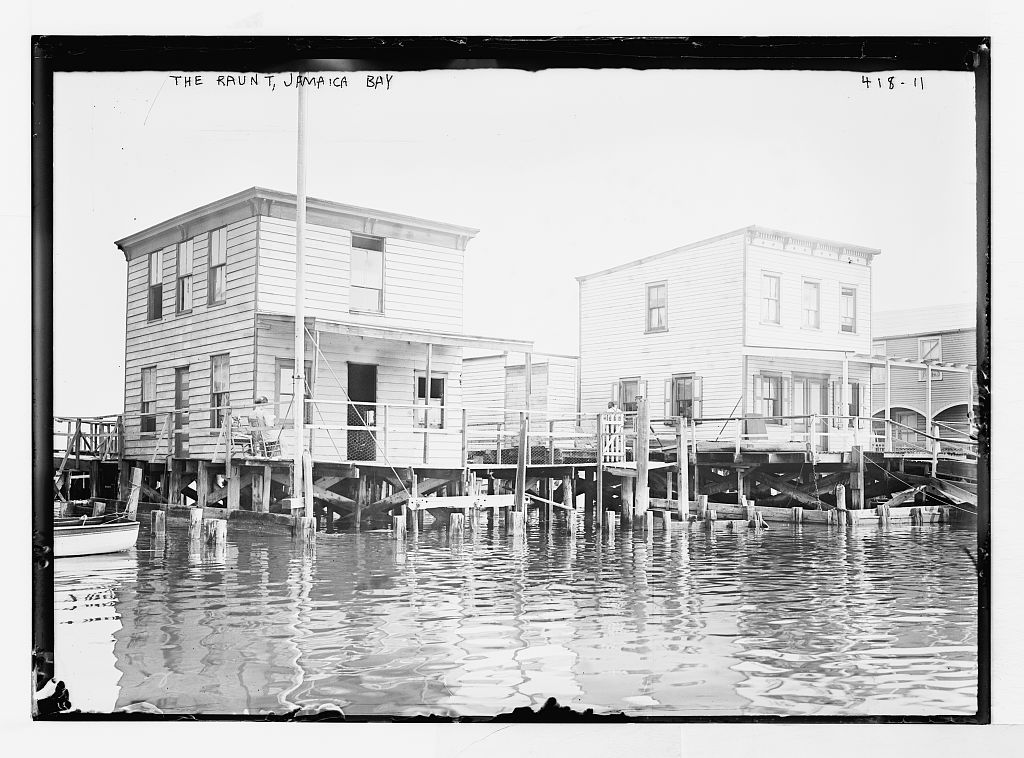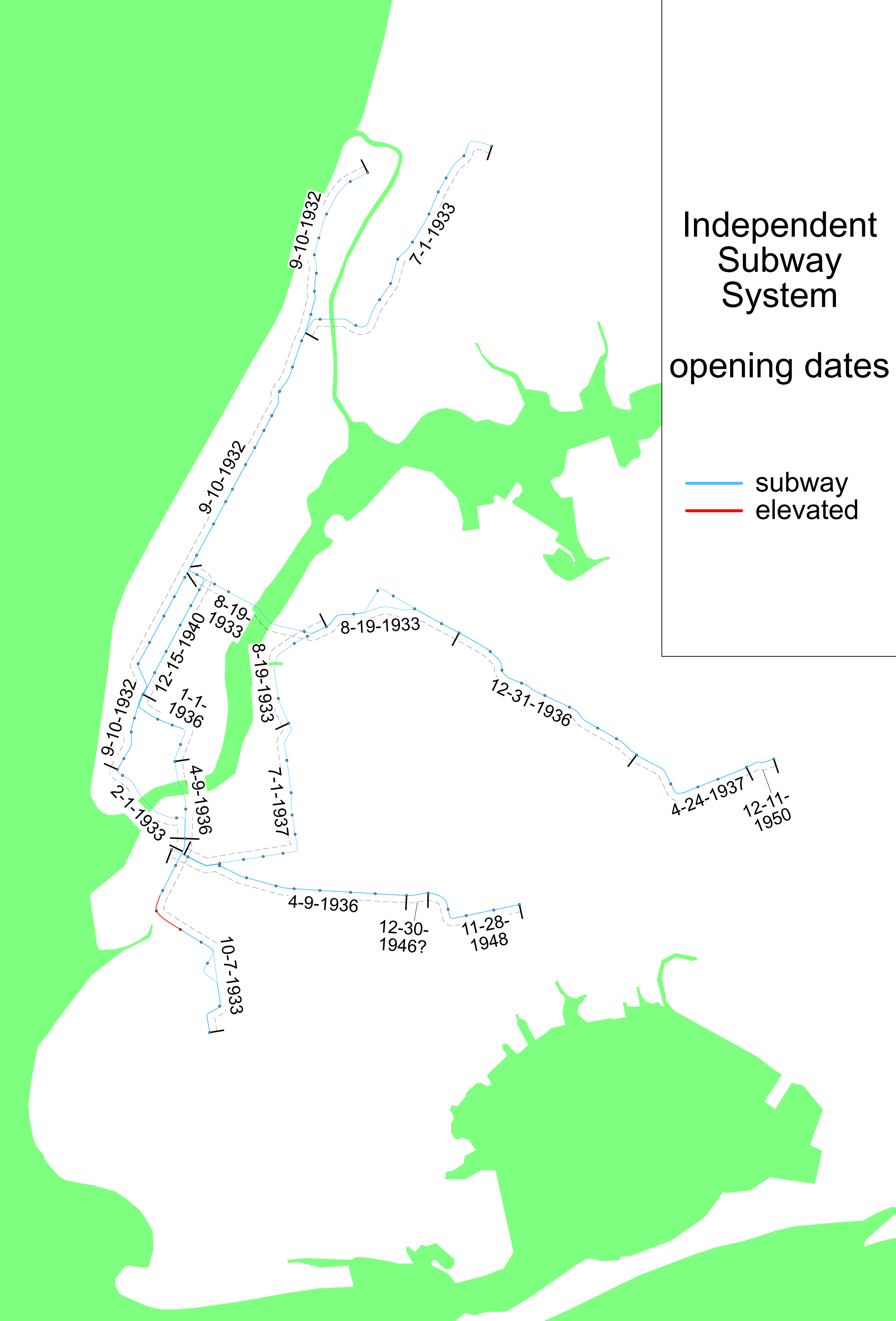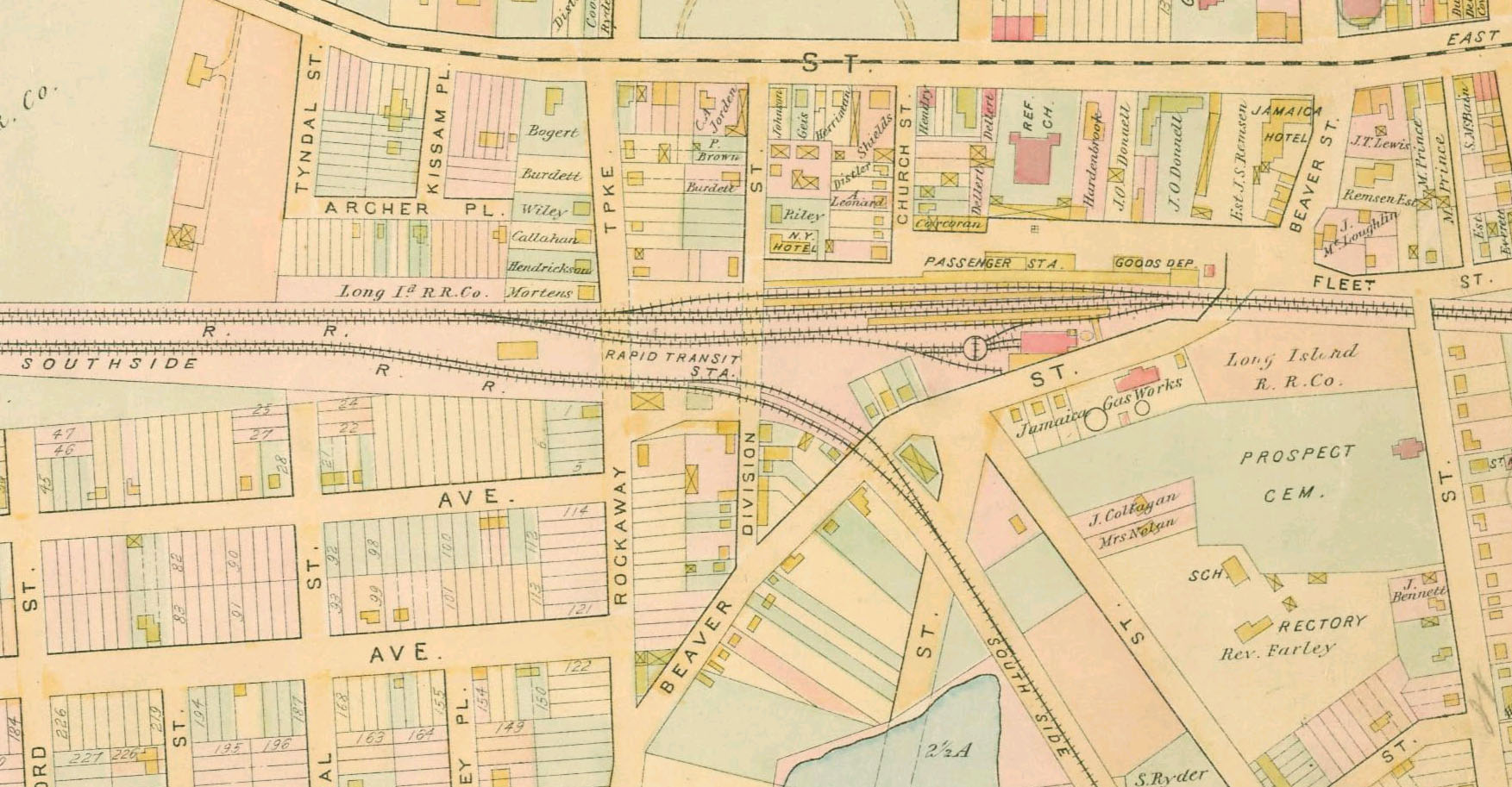|
Woodhaven Junction (LIRR Station)
Woodhaven Junction was a station complex on the Atlantic Branch and Rockaway Beach Branch of the Long Island Rail Road, located at Atlantic Avenue between 98th and 100th Streets in Woodhaven, Queens, New York City. The elevated Rockaway Beach station was closed in 1962 along with the rest of the branch, while the underground Atlantic Branch station was closed and abandoned on January 7, 1977. History Early history The station was first opened by the LIRR in the 1880s for the Rockaway Beach Branch (then known as the New York, Woodhaven and Rockaway Railroad), and in 1893 for the Atlantic Branch. Renovation Beginning in May 1940, both stations were rebuilt when the Atlantic Branch was grade separated and placed in a tunnel. The elevated Rockaway Beach station opened in September 1941, while the underground Atlantic Branch station opened for service on December 28, 1942. Decline and closing In the early expansion plans of the city's Independent Subway System in the 1930s, the Ro ... [...More Info...] [...Related Items...] OR: [Wikipedia] [Google] [Baidu] |
Woodhaven Station
Woodhaven is a former railroad and trolley station on the Atlantic Branch of the Long Island Rail Road. Though it was also on one of the same lines as Woodhaven Junction (LIRR station) the two stations were distinguished from one another. Woodhaven was located on Atlantic Avenue, east of 87th Street. History Woodhaven station was a replacement for another station further to the east known as "Trotting Course Lane," which itself originally opened as Connecticut Avenue Station on July 31, 1837, by the Brooklyn and Jamaica Railroad at 94th Street. The name was changed to "Trotting Course Station," and then Trotting Course Lane Station" for service to horse racing fans at the 1825-built Centerville Race Course. Trotting Course Lane station closed in 1842. Very little evidence of the existence of the street near the tracks, let alone the station can be found today. Six years later, a new station would be built west of Trotting Course Lane. Originally known as Woodville station, it wa ... [...More Info...] [...Related Items...] OR: [Wikipedia] [Google] [Baidu] |
The Raunt (LIRR Station)
The Raunt was a former Long Island Rail Road station on the Rockaway Beach Branch. It had no address and no station house, because it was meant strictly as a dropping-off point for fishermen using a small island in Jamaica Bay. The station was located west of signal station "ER" (presumably #96), and near the WU Tower. It was named for the channel on the south side of the island where it stood. History The Raunt station opened in 1888 by the New York and Rockaway Beach Railway. It had a wooden pedestrian bridge between the two sheltered platforms, and was electrified on July 26, 1905. The Jamaica Bay Trestle was prone to fires, but The Raunt was the source of a May 7–8, 1950 fire that broke out between here and Broad Channel, destroyed the bridge over Jamaica Bay and thus doomed the entire line. Service on the Rockaway Beach Branch west of Hammels continued only via the Far Rockaway Branch, until October 3, 1955, when the branch was abandoned west of Far Rockaway itself, along w ... [...More Info...] [...Related Items...] OR: [Wikipedia] [Google] [Baidu] |
Railway Stations Closed In 1977
Rail transport (also known as train transport) is a means of transport that transfers passengers and goods on wheeled vehicles running on rails, which are incorporated in tracks. In contrast to road transport, where the vehicles run on a prepared flat surface, rail vehicles (rolling stock) are directionally guided by the tracks on which they run. Tracks usually consist of steel rails, installed on sleepers (ties) set in ballast, on which the rolling stock, usually fitted with metal wheels, moves. Other variations are also possible, such as "slab track", in which the rails are fastened to a concrete foundation resting on a prepared subsurface. Rolling stock in a rail transport system generally encounters lower frictional resistance than rubber-tyred road vehicles, so passenger and freight cars (carriages and wagons) can be coupled into longer trains. The operation is carried out by a railway company, providing transport between train stations or freight customer faciliti ... [...More Info...] [...Related Items...] OR: [Wikipedia] [Google] [Baidu] |
Railway Stations In The United States Opened In 1886
Rail transport (also known as train transport) is a means of transport that transfers passengers and goods on wheeled vehicles running on rails, which are incorporated in tracks. In contrast to road transport, where the vehicles run on a prepared flat surface, rail vehicles (rolling stock) are directionally guided by the tracks on which they run. Tracks usually consist of steel rails, installed on sleepers (ties) set in ballast, on which the rolling stock, usually fitted with metal wheels, moves. Other variations are also possible, such as "slab track", in which the rails are fastened to a concrete foundation resting on a prepared subsurface. Rolling stock in a rail transport system generally encounters lower frictional resistance than rubber-tyred road vehicles, so passenger and freight cars (carriages and wagons) can be coupled into longer trains. The operation is carried out by a railway company, providing transport between train stations or freight customer faciliti ... [...More Info...] [...Related Items...] OR: [Wikipedia] [Google] [Baidu] |
Railway Stations In Queens, New York
Rail transport (also known as train transport) is a means of transport that transfers passengers and goods on wheeled vehicles running on rails, which are incorporated in Track (rail transport), tracks. In contrast to road transport, where the vehicles run on a prepared flat surface, rail vehicles (rolling stock) are directionally guided by the tracks on which they run. Tracks usually consist of steel rails, installed on Railroad tie, sleepers (ties) set in track ballast, ballast, on which the rolling stock, usually fitted with metal wheels, moves. Other variations are also possible, such as "slab track", in which the rails are fastened to a concrete foundation resting on a prepared subsurface. Rolling stock in a rail transport system generally encounters lower friction, frictional resistance than rubber-tyred road vehicles, so passenger and freight cars (carriages and wagons) can be coupled into longer trains. The rail transport operations, operation is carried out by a ... [...More Info...] [...Related Items...] OR: [Wikipedia] [Google] [Baidu] |
Former Long Island Rail Road Stations In New York City
A former is an object, such as a template, gauge or cutting die, which is used to form something such as a boat's hull. Typically, a former gives shape to a structure that may have complex curvature. A former may become an integral part of the finished structure, as in an aircraft fuselage, or it may be removable, being using in the construction process and then discarded or re-used. Aircraft formers Formers are used in the construction of aircraft fuselage, of which a typical fuselage has a series from the nose to the empennage, typically perpendicular to the longitudinal axis of the aircraft. The primary purpose of formers is to establish the shape of the fuselage and reduce the column length of stringers to prevent instability. Formers are typically attached to longerons, which support the skin of the aircraft. The "former-and-longeron" technique (also called stations and stringers) was adopted from boat construction, and was typical of light aircraft built until the ad ... [...More Info...] [...Related Items...] OR: [Wikipedia] [Google] [Baidu] |
School Bus
A school bus is any type of bus owned, leased, contracted to, or operated by a school or school district. It is regularly used to transport students to and from school or school-related activities, but not including a charter bus or transit bus. Various configurations of school buses are used worldwide; the most iconic examples are the yellow school buses of the United States and Canada which are also found in other parts of the world. In North America, school buses are purpose-built vehicles distinguished from other types of buses by design characteristics mandated by federal and state/province regulations. In addition to their distinct paint color (school bus yellow), school buses are fitted with exterior warning lights (to give them traffic priority) and multiple safety devices. [...More Info...] [...Related Items...] OR: [Wikipedia] [Google] [Baidu] |
Independent Subway
The Independent Subway System (IND or ISS), formerly known as the Independent City-Owned Subway System (ICOSS) or the Independent City-Owned Rapid Transit Railroad (ICORTR), was a rapid transit rail system in New York City that is now part of the New York City Subway. It was first constructed as the Eighth Avenue Line in Manhattan in 1932. One of three rail networks that became part of the modern New York City subway, the IND was intended to be fully owned and operated by the municipal government, in contrast to the privately operated or jointly funded Interborough Rapid Transit Company (IRT) and Brooklyn–Manhattan Transit Corporation (BMT) companies. It was merged with these two networks in 1940. The original IND service lines are the modern subway's A, B, C, D, E, F, and G services. In addition, the BMT's M, N, Q and R now run partly on IND trackage. The Rockaway Park Shuttle supplements the A service. For operational purposes, the IND and BMT lines and servi ... [...More Info...] [...Related Items...] OR: [Wikipedia] [Google] [Baidu] |
Jamaica (LIRR Station)
Jamaica station is a major train station of the Long Island Rail Road located in Jamaica, Queens, New York City. With weekday ridership exceeding 200,000 passengers, it is the largest transit hub on Long Island, the fourth-busiest rail station in North America, and the second-busiest station that exclusively serves commuter traffic. It is the third-busiest rail hub in the New York area, behind Penn Station and Grand Central Terminal. Over 1,000 trains pass through each day, the fourth-most in the New York area behind Penn Station, Grand Central Terminal, and Secaucus Junction. The Jamaica station is located on an embankment above street level and contains six platforms and ten tracks for LIRR trains. A concourse above the LIRR platforms connects to a station on the AirTrain JFK elevated people mover to John F. Kennedy International Airport, which contains two tracks and one platform. There are also connections to the Archer Avenue lines of the New York City Subway at a s ... [...More Info...] [...Related Items...] OR: [Wikipedia] [Google] [Baidu] |
East New York (LIRR Station)
The East New York station is a station on the Long Island Rail Road's Atlantic Branch in the East New York and Ocean Hill neighborhoods of Brooklyn, New York City, where that branch passes through the Jamaica Pass. It is generally served by the Far Rockaway, Hempstead, and West Hempstead Branches of the LIRR. The East New York station also formerly served the LIRR's Bay Ridge Branch until passenger service on that branch ended in 1924. Station layout This station is located at ground level, in the median of Atlantic Avenue, and underneath the elevated main lanes of Atlantic Avenue, with one eight-car side platform on either side of the two-track line. A closed ticket office is located in the underpass, which has staircases to the southwest corner of East New York and Atlantic avenues and the northwest corner of Van Sinderen and Atlantic avenues. On either side of the station, the tracks submerge into a tunnel, allowing the main lanes of Atlantic Avenue to return to the surfac ... [...More Info...] [...Related Items...] OR: [Wikipedia] [Google] [Baidu] |
City Terminal Zone
The City Terminal Zone, also known as the City Zone Branch, is a collection of rail lines of the Long Island Rail Road within New York City. Specifically, it includes all stations in fare zone 1 (except for Mets–Willets Point on the Port Washington Branch), which is the set of stations west of the Jamaica station. Routes Current routes There are three routes that are part of the City Terminal Zone: * New York Penn Station (NYP) – Trains that, from Jamaica, travel west along the Main Line to Penn Station in Manhattan via the East River Tunnels. * Atlantic Terminal (AT) – Trains that travel along the Atlantic Branch to Brooklyn. * Long Island City (LIC) – Trains that serve Hunterspoint Avenue and Long Island City in Queens. These trains also use the Main Line west of Jamaica, but typically skip Woodside, Forest Hills, and Kew Gardens. This route is served only during weekday rush hours in the peak direction (to Long Island City in the morning, from Long Island City i ... [...More Info...] [...Related Items...] OR: [Wikipedia] [Google] [Baidu] |







